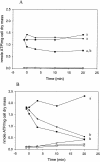Increased ATPase activity is responsible for acid sensitivity of nisin-resistant Listeria monocytogenes ATCC 700302
- PMID: 15128523
- PMCID: PMC404400
- DOI: 10.1128/AEM.70.5.2717-2721.2004
Increased ATPase activity is responsible for acid sensitivity of nisin-resistant Listeria monocytogenes ATCC 700302
Abstract
The growth of the foodborne pathogen Listeria monocytogenes can be controlled by nisin, an antimicrobial peptide. A spontaneous mutant of L. monocytogenes shows both resistance to nisin and increased acid sensitivity compared to the wild type. Changes in the cell membrane correlated with nisin resistance, but the mechanism for acid sensitivity appears unrelated. When hydrochloric or lactic acid is added to cultures, intracellular ATP levels drop significantly in the mutant (P < 0.01) compared to the results seen with the wild type. Characterization of the F(0)F(1) ATPase, which hydrolyzes ATP to pump protons from the cell cytoplasm, shows that the enzyme is more active in the mutant than in the wild type. These data support a model in which the increased activity of the mutant ATPase upon acid addition depletes the cells' supply of ATP, resulting in cell death.
Figures





Similar articles
-
Synergy between nisin and select lactates against Listeria monocytogenes is due to the metal cations.J Food Prot. 2003 Sep;66(9):1631-6. doi: 10.4315/0362-028x-66.9.1631. J Food Prot. 2003. PMID: 14503717
-
sigma(B) and sigma(L) contribute to Listeria monocytogenes 10403S response to the antimicrobial peptides SdpC and nisin.Foodborne Pathog Dis. 2009 Nov;6(9):1057-65. doi: 10.1089/fpd.2009.0292. Foodborne Pathog Dis. 2009. PMID: 19642919 Free PMC article.
-
Bioenergetic mechanism for nisin resistance, induced by the acid tolerance response of Listeria monocytogenes.Appl Environ Microbiol. 2006 Apr;72(4):2556-63. doi: 10.1128/AEM.72.4.2556-2563.2006. Appl Environ Microbiol. 2006. PMID: 16597957 Free PMC article.
-
Mechanism of synergistic inhibition of Listeria monocytogenes growth by lactic acid, monolaurin, and nisin.Appl Environ Microbiol. 2008 Dec;74(23):7126-9. doi: 10.1128/AEM.01292-08. Epub 2008 Sep 26. Appl Environ Microbiol. 2008. PMID: 18820062 Free PMC article.
-
Consequences of the development of nisin-resistant Listeria monocytogenes in fermented dairy products.J Food Prot. 2005 Nov;68(11):2383-8. doi: 10.4315/0362-028x-68.11.2383. J Food Prot. 2005. PMID: 16300077
Cited by
-
Antibacterial Mode of Action of Ib-AMP1 Against Escherichia coli O157:H7.Probiotics Antimicrob Proteins. 2013 Jun;5(2):131-41. doi: 10.1007/s12602-013-9127-1. Probiotics Antimicrob Proteins. 2013. PMID: 26782738
-
Insertional mutagenesis to generate lantibiotic resistance in Lactococcus lactis.Appl Environ Microbiol. 2007 Jul;73(14):4677-80. doi: 10.1128/AEM.02351-06. Epub 2007 May 25. Appl Environ Microbiol. 2007. PMID: 17526796 Free PMC article.
-
Intermittent proton bursts of single lactic acid bacteria.Chem Sci. 2024 Jan 25;15(10):3516-3523. doi: 10.1039/d3sc06238d. eCollection 2024 Mar 6. Chem Sci. 2024. PMID: 38455010 Free PMC article.
-
Changes in Listeria monocytogenes membrane fluidity in response to temperature stress.Appl Environ Microbiol. 2007 Oct;73(20):6429-35. doi: 10.1128/AEM.00980-07. Epub 2007 Aug 17. Appl Environ Microbiol. 2007. PMID: 17704268 Free PMC article.
-
Transcriptomic and phenotypic responses of Listeria monocytogenes strains possessing different growth efficiencies under acidic conditions.Appl Environ Microbiol. 2010 Jul;76(14):4836-50. doi: 10.1128/AEM.00315-10. Epub 2010 May 28. Appl Environ Microbiol. 2010. PMID: 20511423 Free PMC article.
References
-
- Bradford, M. M. 1976. A rapid and sensitive method for the quantitation of microgram quantities of protein utilizing the principle of protein-dye binding. Anal. Biochem. 72:248-254. - PubMed
-
- Breukink, E., I. Wiedemann, C. van Kraaij, O. P. Kuipers, H. Sahl, and B. de Kruijff. 1999. Use of the cell wall precursor lipid II by a pore-forming peptide antibiotic. Science 286:2361-2364. - PubMed
-
- Cotter, P. D., C. G. Gahan, and C. Hill. 2000. Analysis of the role of the Listeria monocytogenes F0F1-ATPase operon in the acid tolerance response. Int. J. Food Microbiol. 60:137-146. - PubMed
Publication types
MeSH terms
Substances
Grants and funding
LinkOut - more resources
Full Text Sources
Medical

